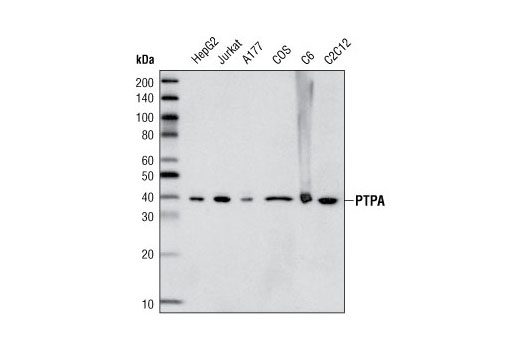WB
H M R Mk
Endogenous
40
Rabbit
#Q15257
5524
Product Information
Product Usage Information
| Application | Dilution |
|---|---|
| Western Blotting | 1:1000 |
Storage
Specificity / Sensitivity
Species Reactivity:
Human, Mouse, Rat, Monkey
Source / Purification
Polyclonal antibodies are produced by immunizing animals with a synthetic peptide corresponding to the sequence of human PTPA. Antibodies are purified by protein A and peptide affinity chromatography.
Background
Protein phosphatase type 2A (PP2A) is an essential protein serine/threonine phosphatase that is conserved in all eukaryotes. PP2A is a key enzyme within various signal transduction pathways as it regulates fundamental cellular activities such as DNA replication, transcription, translation, metabolism, cell cycle progression, cell division, apoptosis and development (1-3). Active protein phosphatase 2A is composed of both structural (A) and catalytic (C) proteins, and its activity relies on interaction with regulatory (B) subunits. An important PP2A regulatory subunit is PP2A phosphatase activator (PTPA), also known as the PP2A activator regulatory subunit 4 (PPP2R4) (4). This PTPA regulatory protein binds ATP and has isomerase (PPIase) activity, suggesting that PP2A regulation involves a change in phosphatase conformation. The addition of ATP (and Mg2+) results in a correlated increase in both PP2A activation and PTPA isomerase activity (5). While the exact mechanism is still under consideration, evidence suggests that binding of PTPA to the PP2A A-C dimer produces a conformational change in PP2A that shifts phosphatase substrate specificity from phosphoserine to phosphotyrosine substrates (6).
- Janssens, V. and Goris, J. (2001) Biochem J 353, 417-39.
- Zolnierowicz, S. (2000) Biochem Pharmacol 60, 1225-35.
- Millward, T.A. et al. (1999) Trends Biochem Sci 24, 186-91.
- Fellner, T. et al. (2003) Genes Dev 17, 2138-50.
- Jordens, J. et al. (2006) J Biol Chem 281, 6349-57.
- Chao, Y. et al. (2006) Mol Cell 23, 535-46.
Species Reactivity
Species reactivity is determined by testing in at least one approved application (e.g., western blot).
Western Blot Buffer
IMPORTANT: For western blots, incubate membrane with diluted primary antibody in 5% w/v BSA, 1X TBS, 0.1% Tween® 20 at 4°C with gentle shaking, overnight.
Applications Key
WB: Western Blotting
Cross-Reactivity Key
H: human M: mouse R: rat Hm: hamster Mk: monkey Vir: virus Mi: mink C: chicken Dm: D. melanogaster X: Xenopus Z: zebrafish B: bovine Dg: dog Pg: pig Sc: S. cerevisiae Ce: C. elegans Hr: horse GP: Guinea Pig Rab: rabbit All: all species expected
Trademarks and Patents
Limited Uses
Except as otherwise expressly agreed in a writing signed by a legally authorized representative of CST, the following terms apply to Products provided by CST, its affiliates or its distributors. Any Customer's terms and conditions that are in addition to, or different from, those contained herein, unless separately accepted in writing by a legally authorized representative of CST, are rejected and are of no force or effect.
Products are labeled with For Research Use Only or a similar labeling statement and have not been approved, cleared, or licensed by the FDA or other regulatory foreign or domestic entity, for any purpose. Customer shall not use any Product for any diagnostic or therapeutic purpose, or otherwise in any manner that conflicts with its labeling statement. Products sold or licensed by CST are provided for Customer as the end-user and solely for research and development uses. Any use of Product for diagnostic, prophylactic or therapeutic purposes, or any purchase of Product for resale (alone or as a component) or other commercial purpose, requires a separate license from CST. Customer shall (a) not sell, license, loan, donate or otherwise transfer or make available any Product to any third party, whether alone or in combination with other materials, or use the Products to manufacture any commercial products, (b) not copy, modify, reverse engineer, decompile, disassemble or otherwise attempt to discover the underlying structure or technology of the Products, or use the Products for the purpose of developing any products or services that would compete with CST products or services, (c) not alter or remove from the Products any trademarks, trade names, logos, patent or copyright notices or markings, (d) use the Products solely in accordance with CST Product Terms of Sale and any applicable documentation, and (e) comply with any license, terms of service or similar agreement with respect to any third party products or services used by Customer in connection with the Products.
